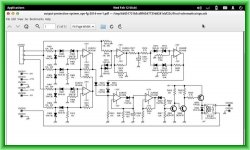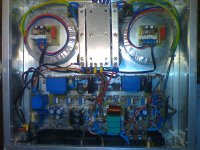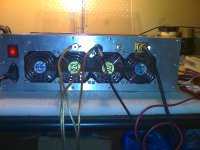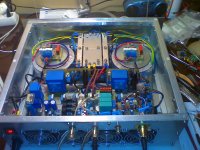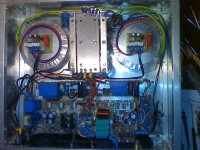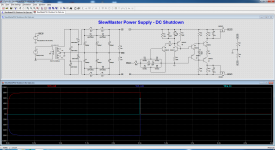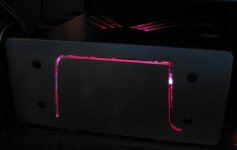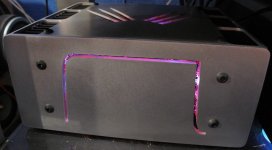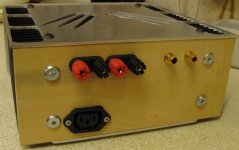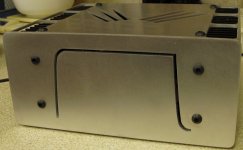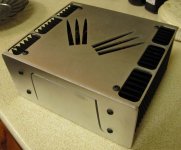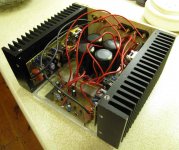simple short circuit protection
Video - TinyPic - Free Image Hosting, Photo Sharing & Video Hosting
Hello
greetings short circuit protection is important sometimes by mistake speaker wires get shorted tried a short circuit protection on a 100 watt amp it works have to experiment
with a universal HIGH POWER version can post schematic if anyone is interested
warm regards
Andrew
Video - TinyPic - Free Image Hosting, Photo Sharing & Video Hosting
Hello
greetings short circuit protection is important sometimes by mistake speaker wires get shorted tried a short circuit protection on a 100 watt amp it works have to experiment
with a universal HIGH POWER version can post schematic if anyone is interested
warm regards
Andrew
That i tried to do with the protection circuit in my signature.I think power supply with shutdown triggered by SOA protection, DC offset protection, temperature protection, etc can be made optional. If someone want it, he can add the components. We must define the interface of this OPS to the power supply.
Then everything are modular 😀
The idea is very simple: To compare the input signal with the output one. If any difference (DC, short circuit in the speakers cables, oscillation, etc...) it will fire instant, because there is no integration.
The circuit looks pretty complex, because all the options (soft and silent start, silent off and other refinements, like temperature monitoring, but the principle is very simple and can be realized with a single OPA and one transistor.
The main advantage is the circuit is independent from the amplifier, can run outside of it.
The inconvenient is it will fire if you saturate the amp ;-)
Last edited:
short circuit protection
The circuit looks pretty complex, because all the options (soft and silent start, silent off and other refinements, like temperature monitoring, but the principle is very simple and can be realized with a single OPA and one transistor
Hello Esperado
greetings can you share a simple short circuit protection schematic
your Ultimate short protector is one of the best but due to double sided pcb
and hard to get components i could not make it PLEASE if you can share a simple design
warm regards
Andrew
The circuit looks pretty complex, because all the options (soft and silent start, silent off and other refinements, like temperature monitoring, but the principle is very simple and can be realized with a single OPA and one transistor
Hello Esperado
greetings can you share a simple short circuit protection schematic
your Ultimate short protector is one of the best but due to double sided pcb
and hard to get components i could not make it PLEASE if you can share a simple design
warm regards
Andrew
short protect schematic
Hello
greetings any views on this short protector schematic would it work
PIN 1 connected to emitter of positive output trs
PIN2 connected to output of amplifier
PIN3 connected to emitter of negative output trs
warm regards
Andrew😕
Hello
greetings any views on this short protector schematic would it work
PIN 1 connected to emitter of positive output trs
PIN2 connected to output of amplifier
PIN3 connected to emitter of negative output trs
warm regards
Andrew😕
Attachments
That i tried to do with the protection circuit in my signature.
The idea is very simple: To compare the input signal with the output one. If any difference (DC, short circuit in the speakers cables, oscillation, etc...) it will fire instant, because there is no integration.
The circuit looks pretty complex, because all the options (soft and silent start, silent off and other refinements, like temperature monitoring, but the principle is very simple and can be realized with a single OPA and one transistor.
The main advantage is the circuit is independent from the amplifier, can run outside of it.
The inconvenient is it will fire if you saturate the amp ;-)
Did you mean, the output amp attenuate at the same level as input signal, then feed them into differential amp using op-amp?
Last edited:
Indeed.Did you mean, the output amp attenuate at the same level as input signal, then feed them into differential amp using op-amp?
Andrew, there is nothing esoteric. I used a very fast OPA for comparator in order to minimise phase shift for comparing the signal, but you can use even TL072/74, it will just be less sensible to oscillations after 5/10MHz.greetings can you share a simple short circuit protection schematic
your Ultimate short protector is one of the best but due to double sided pcb
and hard to get components i could not make it PLEASE if you can share a simple design
The option to use both mechanical relay and MOS is just to ensure the fastest and most transparent operation achievable. In my own amp, i use a more simple circuit with just a relay.
What the hell about double sized PCB ?
All this reminds me of a circuit elektor protection TITAN 2000
Attachments
Last edited:
I have to say, I do like the idea behind that kind of protection scheme. My only concern, and it's a small one, would be that this protection scheme would trigger if the amplifier clips. You've mentioned this yourself, but it does mean that if there's a transient that triggers it, that would normally not be any cause for concern, that your music would cut out. It's also no replacement for SOA protection.
Now for a progress update. I've finally got my Wolverine build completed, the only thing left to do is replace the MJE340/350s with the KSA/KSC parts for the pre drivers. I ran out of KSA1381s with the CFA build >.<.
This is pretty much a cosmetic update rather than anything practical but I have now added a turn on delay/DC detect circuit with MOSFET relay. This can be seen in the first picture.

The PCB at the front of the chassis is what does the loudspeaker protecting and it works very well.
As you can see the amplifier has an aluminium plate on the bottom with holes for ventilation. Next up are three pictures with the front and top plate in place.



As can be seen the parts are made out of sanded aluminium. In the UK we have a company called Lasermaster that will laser cut designs out of various metals at very reasonable prices, so this is where these came from. The three parts, the top plate, out of 3mm alu, the bottom plate, out of 3mm alu and the front, out of 6mm alu, came in at less than £20. I had to do all the sanding, but it's definitely worth the money.
Next up are two pictures with the amplifier actually turned on.


This is where the super bright blue and red LEDs come in 😀 It seemed a crying shame to shut out all that light so I figured having some decent sized shapes cut out of the top and front would be a nice touch.
If you haven't figured it out, the shape cut out on the front is a homage to the 'Slew Master' output stage and the shape on the top is a homage to the 'Wolverine' input stage and to Wolverine from the X-men with his signature three bladed slash.
The light show fits in rather well with the rest of the hifi which is similarly illuminated.

The unit at the top with the OLED display is the DSP unit, the one below it is the 4 channel CFA-XH (soon to be updated) and then below is the wolverine and the thing with the single Mysteron eye houses the two transformers for the wolverine and the CFA.
Now for a progress update. I've finally got my Wolverine build completed, the only thing left to do is replace the MJE340/350s with the KSA/KSC parts for the pre drivers. I ran out of KSA1381s with the CFA build >.<.
This is pretty much a cosmetic update rather than anything practical but I have now added a turn on delay/DC detect circuit with MOSFET relay. This can be seen in the first picture.
The PCB at the front of the chassis is what does the loudspeaker protecting and it works very well.
As you can see the amplifier has an aluminium plate on the bottom with holes for ventilation. Next up are three pictures with the front and top plate in place.
As can be seen the parts are made out of sanded aluminium. In the UK we have a company called Lasermaster that will laser cut designs out of various metals at very reasonable prices, so this is where these came from. The three parts, the top plate, out of 3mm alu, the bottom plate, out of 3mm alu and the front, out of 6mm alu, came in at less than £20. I had to do all the sanding, but it's definitely worth the money.
Next up are two pictures with the amplifier actually turned on.
This is where the super bright blue and red LEDs come in 😀 It seemed a crying shame to shut out all that light so I figured having some decent sized shapes cut out of the top and front would be a nice touch.
If you haven't figured it out, the shape cut out on the front is a homage to the 'Slew Master' output stage and the shape on the top is a homage to the 'Wolverine' input stage and to Wolverine from the X-men with his signature three bladed slash.
The light show fits in rather well with the rest of the hifi which is similarly illuminated.
The unit at the top with the OLED display is the DSP unit, the one below it is the 4 channel CFA-XH (soon to be updated) and then below is the wolverine and the thing with the single Mysteron eye houses the two transformers for the wolverine and the CFA.
Attachments
In practice, and if you tune the sensitivity of the protection at the limit for 1000Hz full power, the amp charged with a pure resistive load, it will fire at the first kick drum at very low level ;-)I do like the idea behind that kind of protection scheme. My only concern, and it's a small one, would be that this protection scheme would trigger if the amplifier clips. You've mentioned this yourself, but it does mean that if there's a transient that triggers it, that would normally not be any cause for concern, that your music would cut out. It's also no replacement for SOA protection.
Looking at the differential signal, it is very interesting to see how behave our perfect amps during transients with a real speaker load !
But you can tune the sensitivity to afford even clipping on your real load.
Any way, a hifi amplifier should *never* saturate.
About SOA, i hope our amplifiers have enough margin to never burn in normal conditions, and the protection is so fast and sensible that i don't see how some accident can lead to this point where your output devices can burn out.
In case something happens in the amp, your speakers will never know. In case of short circuit, DC in the input, or output, both the amp and the speaker will never have time to burn more, and you will not even hear a noise.
I just want to add that i used this kind of protection to secure a BIG professional P.A. system for Rock'n'roll shows (all the worse conditions you can never imagine) and it worked always with no problems.
I discovered something yesterday. The first 4 Slewmonster boards I built have MJL3281/1302 output transistors for the outputs. They have been working flawlessly. I built a third pair to use in a +-90V rail amp and I used MJL21193/21194 output transistors. When testing this pair yesterday I was getting oscillation. Do any of you know if these transistors need different compensation from the others?
Thanks, Terry
Thanks, Terry
I discovered something yesterday. The first 4 Slewmonster boards I built have MJL3281/1302 output transistors for the outputs. They have been working flawlessly. I built a third pair to use in a +-90V rail amp and I used MJL21193/21194 output transistors. When testing this pair yesterday I was getting oscillation. Do any of you know if these transistors need different compensation from the others?
Thanks, Terry
Because the MJL21193/94 are much slower devices (4MHz, compared to 30MHz for the MJL3281/1302), resulting in much more phase shift added by the output stage.
You need to double (at least) the compensation cap(s), to bring the ULGF to a much lower frequency. Of course, the lost HF loop gain will seriously affect the HF distortions.
Not much of an output stage if it cant be fuse protected , just saying .....
Now wayne it is fairly well known I think that BJTs tend to let out the blue smoke faster than a fuse can protect them, at least if one's using a fuse of adequate value so as to not impact on the function of the amplifier under worst, nominal load, situations.
Besides, who wants an amplifier where you have to replace any parts after the OPS has been overloaded?
Because the MJL21193/94 are much slower devices (4MHz, compared to 30MHz for the MJL3281/1302), resulting in much more phase shift added by the output stage.
You need to double (at least) the compensation cap(s), to bring the ULGF to a much lower frequency. Of course, the lost HF loop gain will seriously affect the HF distortions.
Please tell me which are the compensation caps.
Thanks, Terry
Attachments
Last edited:
Csa, Csb.Please tell me which are the compensation caps.
Thanks. I just noticed that it calls for "27R/62p for some drivers." The newest scematic calls for 82p which is what I have in there. What would you recommend for a good value to start with? Is the r-c a good option? I am using MJW3281/1302 for the drivers and the MJL21193/94 for the outputs.
Thanks, Terry
Thanks, Terry
- Home
- Amplifiers
- Solid State
- Slewmaster - CFA vs. VFA "Rumble"
